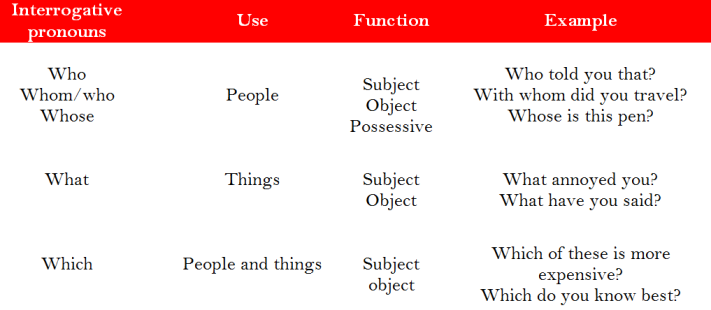What are pronouns?
What are pronouns?
For example
Nadal (noun) is a tennis player. He (pronoun) plays very well.
Now, in the second sentence we use the subject pronoun
(he) instead of the word Nadal, which is a noun, to avoid repetition.
Kinds of pronouns
- Personal pronouns
- Possessive pronouns
- Demonstrative pronouns
- Reflexive pronouns
- Interrogative pronouns
- Relative pronouns
Personal pronouns
To start with, personal pronouns replace nouns in a sentence. They can play the role of a subject and an object.
Subject Pronouns
For example
She (Subject pronoun) speaks (verb) good English.
He (Subject pronoun) is (verb) busy all the tim!
Object of verb
An object pronoun can be used as: Object of the verb (direct/ indirect object)
Direct object
For example
What did Mariah study?
Mariah studied Biology (direct object), last year. She enjoyed it (Biology).
The pronoun “it” replaces the word “Biology”, which is the direct object of this sentence.
Indirect object
For example
Mariah gave them (IO) some money (DO).
In this sentence, we have two objects, one is indirect and the other one is direct.
Object of preposition
For example
I’ll wait for you to come.
Now, the pronoun “you” is an object of preposition “for”.
Possessive pronouns
What are possessive pronouns?
Possessive pronouns are used to substitute possessive
adjectives+ nouns structure.
For example
Where is your car? (adjective+ noun)
Well, it’s in the garage. What about yours?
The possessive pronoun “yours” takes the place of the adjective pronoun” your”.
Possessive pronouns
Demonstrative pronouns
Demonstrative pronouns are words used to point out someone
or something.
We use the demonstrative pronoun “this” to point to a singular near person or thing.
We use “that” to point
to a singular far person or thing.
For example
That runs fast.
That is expensive.
We use “these” to point to a plural near persons or things.
For example
These are my friends.
These look scary.
The demonstrative pronoun “those” is used to mention
plural far persons or things.
For example
Are those, John and Mary?
Reflexive pronouns
What are reflexive pronouns?
Reflexive pronouns are the pronouns which indicate
that the action of the verb is occurring to the doer of the action, the subject
and the object are the same.
For example
Lucy (subject) burns herself (object).
They (subject) defend themselves (object) in the court.
I (subject) will throw it myself (object)!
What are interrogative pronouns?
Interrogative pronouns are question words used to form questions.
Interrogative pronouns are: what/ which/ who/ whom/ whose.
Who as subject
The interrogative pronoun “who” refers to people. It
plays the role of the subject of the sentence.
For example
Who asked you that question?
Who/whom as object
“Who” can be an object, too. Now, in day-to- day
communication, people tend to use who instead of the formal “whom”.
For example
Whom/who do you visit most often?
Whose
The interrogative pronoun “whose” is used in questions
to ask who something belongs to.
For example
Whose is this pen?
It’s John’s pen. (the pen belongs to John)
What
The pronoun “what” is used to talk about things.
In a
question, the word “what” can be a subject as well as an object.
For example
What annoyed you?
The
answer would be “loud music!”
Which
The pronoun “which” is used to talk about people and
things. It can be a subject or an object.
For example
Which lasts longer? (subject)
The red can last longer.
Which will you choose? (object)
I’ll choose the red.
Relative pronouns
What are relative pronouns?
Relative pronouns used in relative clauses, restrictive and non-restrictive relative clauses.
Relative pronouns are: who/
whom/ which/ that/ whose.
In relative clauses, we use the words who, which and
that instead of subject pronouns (he, she, it and they).
We use who and that, mostly who, to refer to people.
For example
The boy who speaks seven languages is my cousin.
The man who/whom I met accidentally asked me some strange questions.
A nurse is someone who takes care of patients.
As object, we use who/whom/that to refer to people.
For example
The woman whom you divorced got married again.
We use which / that when we are talking about things.
For example
The watch that costs $1000 has been stolen.
Whose: possession
We use whose to refer to people and to replace his, her,
their.
For example
I spoke to a man whose accent sounds beautiful!
Laila, whose husband is German, has launched a new book.





Thanks for help.
ReplyDelete